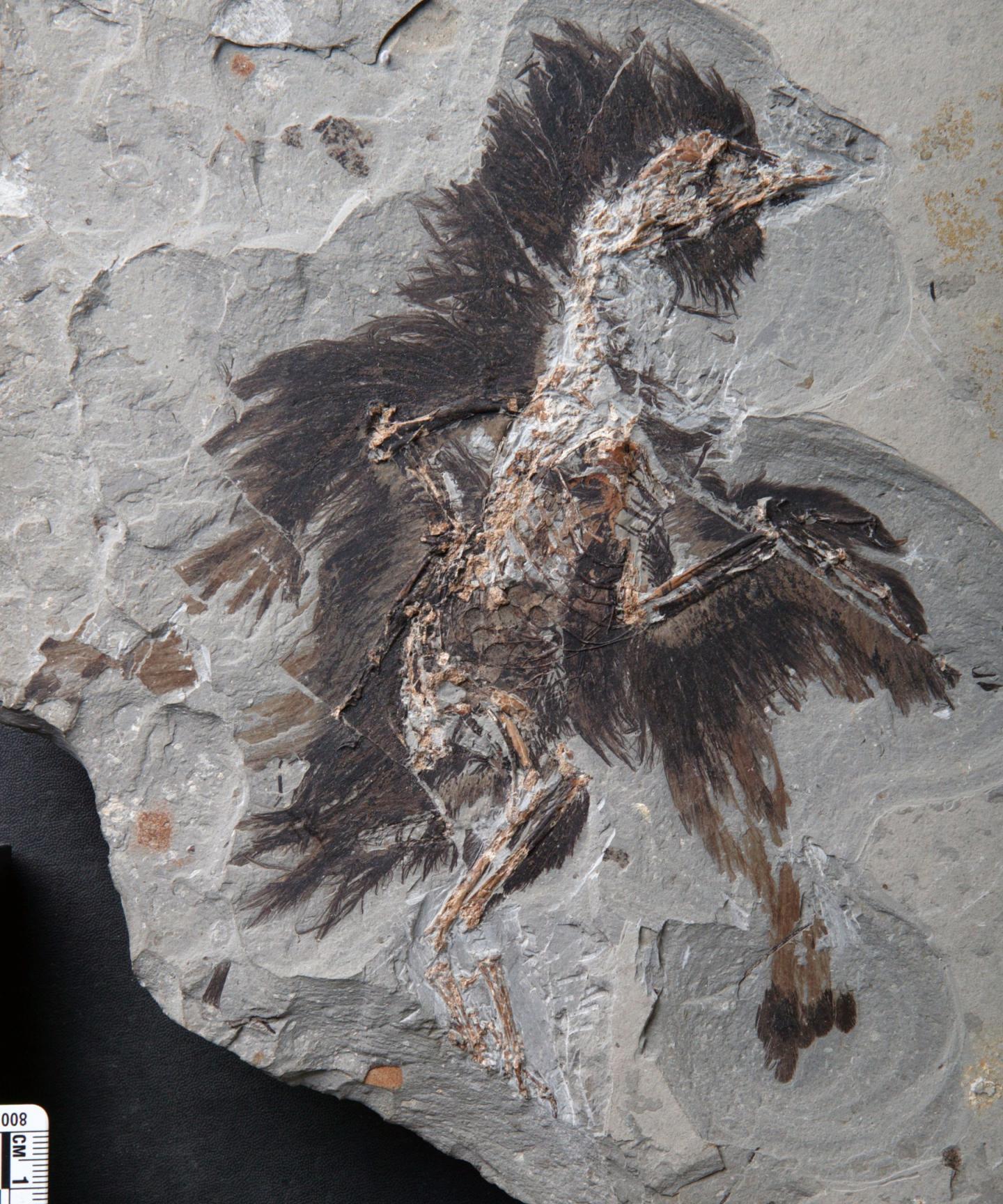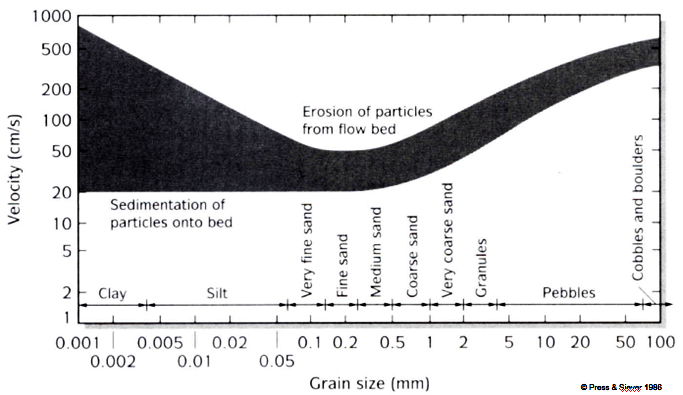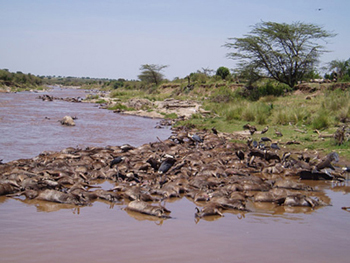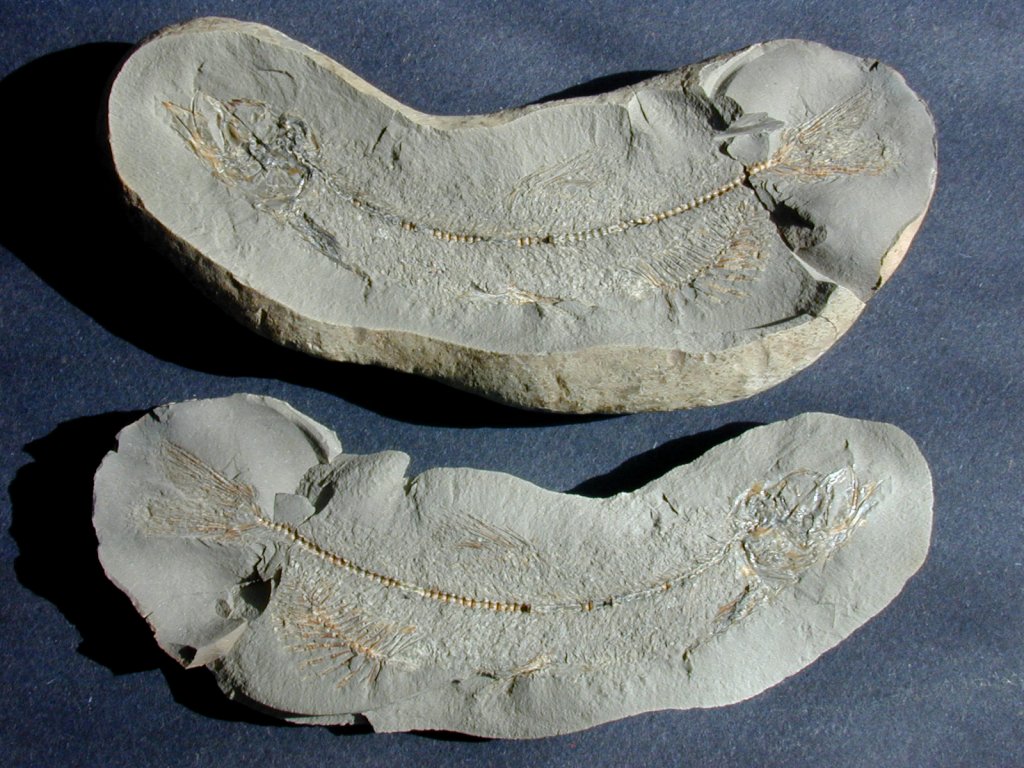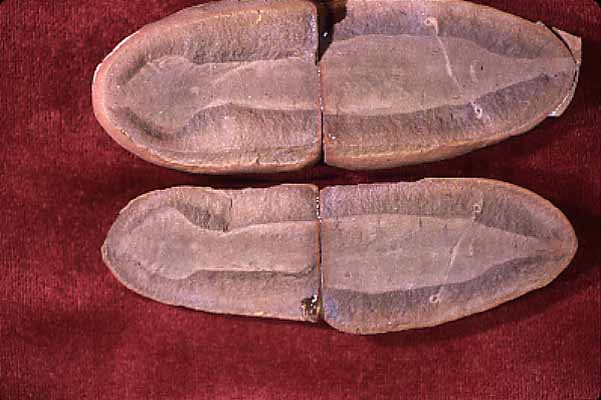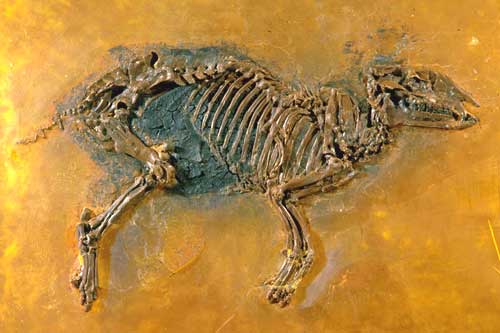The Fossil Record and Vertebrate Taphonomy
John Merck
Taphonomy:
The realm of paleontology dedicated to the study of the processes by which an organism becomes part of the fossil record. Yields an understanding of the filters and biases of the fossil record.
Becoming a fossil:
From the birth of the organism to discovery by a paleontologist, fossils go through four general stages.- Necrolysis:
- Decomposition: destruction of soft tissues by bacteria
- Dissociation: body parts become separated
- Abrasion: surface details of hard parts lost
- Breakage: hard parts degraded into fragments
- Winnowing: fragments sorted by size due to moving water
- Dissolution: hard parts chemically altered into soluble substances
- Compaction: remains crushed by overlying sediment
- Recrystallization: ground water & minerals enter, form crystals & disrupt remains

1.) Biotic stage: - the realm of paleoecology:
Birth to death. The organism grows whatever tissue is capable of being preserved then dies. It has done its part. Whether it will become part of the fossil record depends on whether any parts of its carcass can remain intact long enough to be incorporated into the rock record. The quicker the burial, the better because.....
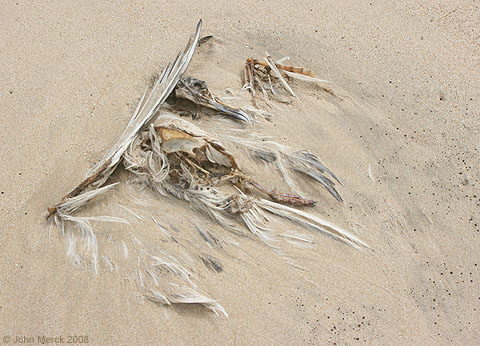
2.) Interment stage - the realm of biostratinomy:
Death to final burial. The carcass is exposed to:
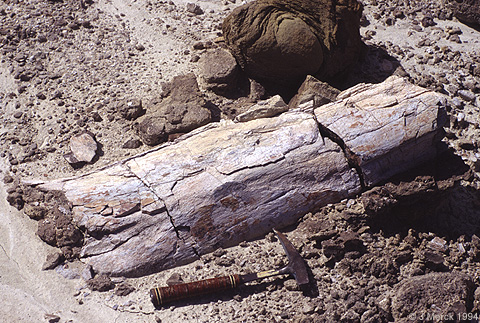
3.) Diagenetic stage - the realm of sedimentology:
Final burial to discovery. Once buried, the remains are officially fossils, however their existence is still perilous. Diagenesis results in:4.) Investigative stage - the realm of Sociology: Discovery to ultimate destruction. Every day, fossils are unearthed by erosion, only quickly to be destroyed by it. To enter the fossil record, as scholars understand it, a fossil must be exhumed (usually by natural processes), discovered, and described. As with the previous stages, this imposes filters and biases.
The Biotic Stage
The organism develops tissues and substances with a range of preservation potential. The greatest potential exists for hard tissues including:
- Calcite and aragonite (CaCO3)
- Silica(SiO2) and opal (SiO2 . 2H2O)
- Apatites (Ca5(PO4)3 ) (right) including the form found in vertebrate bones and teeth - hydroxyapatite (Ca5(PO4)3 (OH))
As a mineral, apatite is relatively durable, so vertebrate skeletal elements that make it into the rock record have a decent shot at long-term preservation. The problem is that phosphate ion is relatively rare and important for metabolism. Thus, vertebrate bodies hoard it, and bony tissue is continually remodeled to provide metabolic access. Not surprisingly, vertebrates secrete skeletal tissue sparingly in comparison to creatures like mollusks with their massive (CaCO3) skeletons. Hydroxyapatite occurs in:
- Bone
- Scales
- Teeth
- Calcified cartilage
Complex organic molecules forming the framework for robust soft tissues: While not exactly "hard parts" some soft tissues form tough parts having reasonably good fossilization potentials. Although susceptible to decomposition, these are tough enough to withstand much of the physical abuse of the interment stage, and can be preserved if they are quickly removed from agents of decomposition. Among vertebrates these include:
- Keratin (a protein) - the primary molecule of animal skin and integument (right)
- Cartilage (a complex composite) - The flexible tissue of the skeleton
- Collagen (a protein) - a fibrous protein forming the basis of many animal connective tissues.
Genuine soft tissues, susceptible to decomposition and mechanical forces, are only rarely preserved as fossils as a result of rapid burial in quiet, anoxic environments. When they are, we make a big fuss, as in the case of Haikouichthys (right) and other soft-bodied creatures from the Cambrian Chengjiang locality.
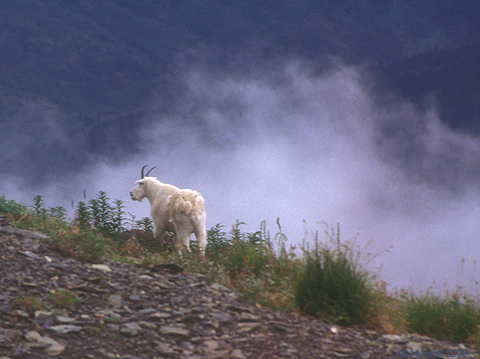
Mountain goat Oreamnos americanus
Response to predation: The hardest, most robust, and least digestible parts of an organism have enhanced preservation potential simply because so many vertebrate remains are processed by predators and scavengers. Thus, teeth are significantly more likely to enter the fossil record than fragile bones.
The Interment Stage
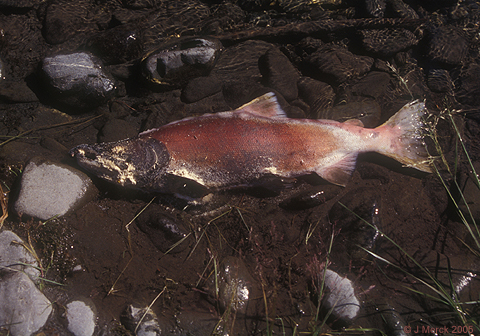
Red salmon shuffles off mortal coil
- Decay: The removal of soft tissues from the carcass is accomplished by everything from bacteria to large carnivores, but microbial action predominates. The speed of decay is a function of:
- pH
- Moisture
- Temperature
- Oxygen concentration.
- Posture: Aspects of decay including:
- Desiccation
- Rigor mortis
- bloating
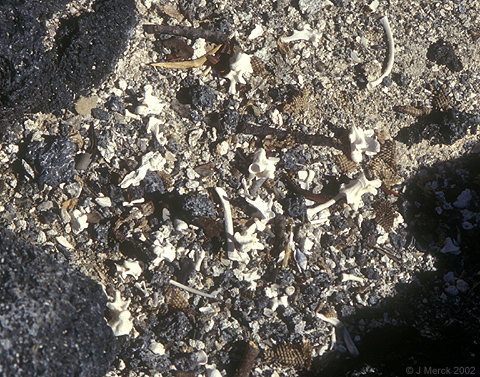
Beach gravel with basalt and marine iguana bones - Fernandina, Galápagos Islands.
- Autochthonous: Buried in their original location.
- Allochthonous: Transported prior to burial.
- Mass-wasting
- Eolian
- Fluvial
- Shoreline
Generally, each transport mode imposes its own filter on the final survival, distribution, and orientation of each element of the body.
- In eolian, lacustrine, floodplain, or marine environments where bone-sized clasts can't be moved, skeletons might be preserved relatively intact.
- In higher-energy environments, especially channels and shorelines, hydrologic processes influence distribution:
- Sorting and winnowing: Elements of the same critter will be spread over increasing areas with increasing transport duration. Lighter elements and those with higher surface area / volume ratios move farther. When more than one carcass is involved, similar sized-elements from many individuals might be deposited together. In 1969, M. R. Voorhies carried out a classic experiment in which the bones of mammals of a wide range of sizes were dropped into a flume (artificial channel) and their behavior noted. From this we identify three Voorhies groups:
- Transport group: Elements that are immediately carried downstream. (ribs, vertebrae, sacrum, sternum)
- Intermediate group: Elements that moved intermittently as bed load. (long bones of the limbs, metatarsals, metacarpals, phalanges)
- Lag group: Elements that largely resisted movement. (skull and jaws)
- Sorting and winnowing: Elements of the same critter will be spread over increasing areas with increasing transport duration. Lighter elements and those with higher surface area / volume ratios move farther. When more than one carcass is involved, similar sized-elements from many individuals might be deposited together. In 1969, M. R. Voorhies carried out a classic experiment in which the bones of mammals of a wide range of sizes were dropped into a flume (artificial channel) and their behavior noted. From this we identify three Voorhies groups:
- Orientation: Unidirectional current tends to orient elements in their most stable position:
- Platy elements with their more convex side up.
- Elongate elements parallel to the predominant current with their more massive ends pointed upstream.
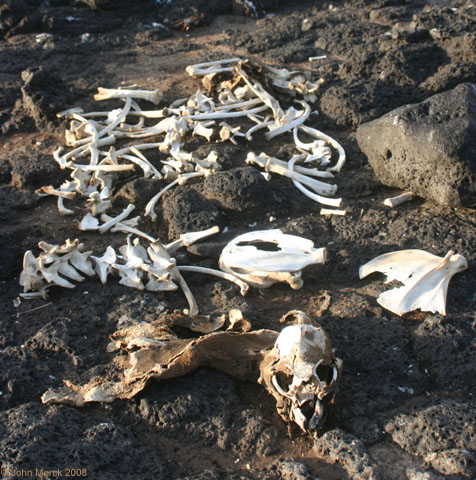
Former sea lion - South Plaza, Galápagos Islands.
In discussing transport, we have treated the skeleton merely as a pile of bones, and considered their relative transportability. In fact, the vertebrate skeleton consists of elements whose articulation - geometric relationship one to another - conveys considerable information. What is the fate of that information upon death?
In the absence of transport agents, disarticulation progresses as scavengers and agents of decay attack the carcass. Thus:
- Beautifully-preserved museum quality specimens occur only when decay is halted by burial or environmental conditions
- Disarticulation progresses from the outside in, with fins, jaws, and limbs becoming disarticulated prior to the thoracic vertebral column. (See the untransported sea lion skeleton at right, in which several thoracic vertebrae remain in articulation in a skeleton that has otherwise fallen apart.)
Identification: Disarticulation is the randomization of the location and orientation of skeletal elements, with disturbance concentrated at the top. If the agents of disarticulation are predators or scavengers, bones will be abraded and broken, also.
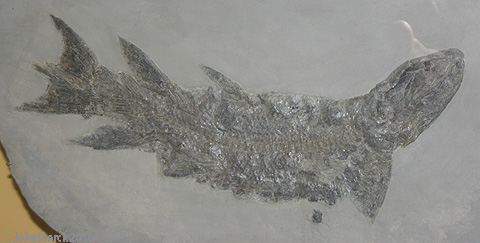
Eusthenopteron foordi a cylindrical fish in two dimensions
Although modification of bone shape and surface texture can happen at any taphonomic stage, it is concentrated in the interment stage. Sources of modification include:
- Traumas and pathologies incurred during life.
- Post-mortem damage due to predation, scavenging, digestion, trampling, abrasion during transport, etc.
- Post-burial diagenetic effects, including dissolution or (commonly) compaction. Its spongy nature makes vertebrate bone susceptible to crushing and compaction compared to the hard tissues of other animals. Thus, we must often interpret three-dimensional structures that have been reduced to two dimensions.
Unlike other clasts, vertebrate elements must put up with other organisms as agents of transport, including:
- Predators: Their activities may concentrate remains near favorite resting places. E.G. cave deposits representing:
- Large carnivore lairs
- Concentrations of owl pellets
- Scavengers: whose effect is to disperse elements
- Trampling: By which elements may be broken, abraded, and significantly reoriented.
The Diagenetic Stage:
- There is a tendency toward substitution of CO32-, and F- anions for OH.
- Low pH promotes dissolution.
- lacunae inhabited, in life, by osteocytes.
- Vascular channels
- Often, the mineral component assumes an open woven form enclosing much pore space.
- Permineralization: It is unusual for this space not to be permineralized by the precipitation of ions from pore fluid (usually silica (SiO2) or opal (SiO2.H2O), but sometimes by phosphates or hematite (Fe2O3).
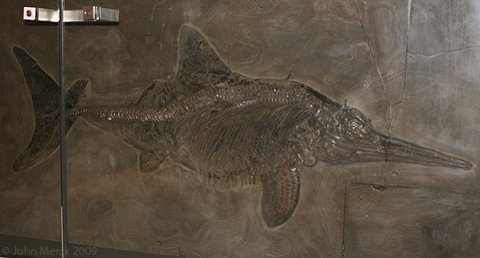
Stenopterygius with carbonized soft tissues from Posidonienschiefer - Holzmaden. - Carbonization: Proteins in rapidly buried soft tissue can be denatured with their more volatile components migrating away to leave a carbon film.
- Authigenic preservation: Soft tissue preservation facilitated by precipitation of mineral films:
- Typically bacterially mediated
- Generally begins VERY quickly (diagenesis starts within hours of burial)
- Rate of burial, salinity, and organic content of sediment and organisms will determine which new (authigenic) minerals form to preserve soft tissue. These include:
- Pyrite (FeS2)
- Carbonates - calcite (CaCO3) and siderite (FeCO3)
- Phosphates - Apatite (Ca5(PO4)3) or vivianite (Fe2+Fe2+2(PO4)2.8H2)
- Silica (SiO2)
- Three common modes of soft tissue preservation by authigenic minerals:
- Permineralization: rare, and only phosphates. Most effective on "hard" soft tissues, like cellulose and chitin
- Mineral coats: most common. May be phosphate, carbonate, or pyrite.
- Tissue casts: rapid stabilization of sediments through diagenesis prior to lithification of rock as a whole. Often as nodules and concretions. May be siliceous or calcareous.
- Rare forms of preservation such as freezing, or encasement in amber.
The Investigative Stage:
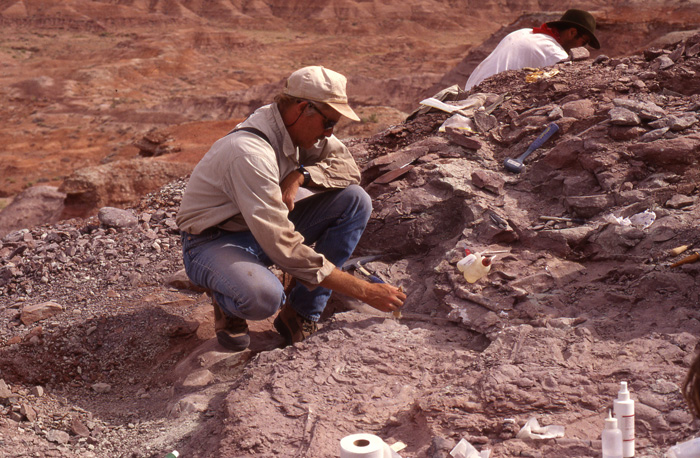
Paleontologist in the field
The realm of Sociology: Discovery to ultimate destruction. Every day, fossils are unearthed by erosion, only quickly to be destroyed by it. To enter the fossil record, as scholars understand it, a fossil must be exhumed (usually by natural processes), discovered, and described. As with the previous stages, this imposes filters and biases including:
- Access by paleontologists: It is no coincidence that the earliest fossil vertebrates to be described scientifically came from the Western European countries where the science of paleontology was established. As paleontologists have travelled abroad and as the science has become established in other nations (the US, China, Canada, South Africa, etc.) the fossils of those countries have become part of the academic record.
- Geography: Some regions are more conducive to paleontological field work than others. No surprise that we know more about the fossils of the western US and western China than we do about those of Congo or Antarctica.
- Research Priorities: There are limits to the number of fossils that can be recovered. Thus, paleontologists prioritize those that favor their research interests. Thus, emphases change over time. For example, the late 19th - early 20th century emphasis on dinosaurs was replaced in the mid 20th century by one on mammalian evolution. This, in turn, was eclipsed during the late 20th century by the "Dinosaur Renaissance" in which dinosaur and bird evolution was emphasized.
Taphonomic Information
Fossil Site Analysis:
Most of the discussion above primarily concerns the history of single individuals. However, much information can be gained by looking at the totality of the fossils from a single horizon (layer) at a single site. This data might include:- Taxonomic diversity: Number of taxa represented
- Relative abundances: How many of each taxon is represented. For macrofossils, this might be calculated as Minimum Numbers of Individuals (MNI) assessed by counting the number of particular common preserved bones (for example, if there is only one skull, three left humeri, and twelve right femora, we know that there were at least 12 individuals)
- Orientation of Fossils: Indicates depositional environment. Randomly oriented fossils may indicate autochthonous deposit; oriented long bones, indicate directionality of flow (and thus likelihood that the deposit is allochthonous and/or at least slightly disturbed)
Lagerstätten:
German mining jargon for "motherload" or "bonanza". However, usually used outside Germany for what is properly "Fossil-Lagerstätten".Adolph Seilacher proposed two major types of Fossil-Lagerstätten:
- Konzentrat-Lagerstätten: anomolously high amounts of fossil material
- Possibly by decreased rate of sedimentation
- Possibly by increased rate of organism reproduction ("bloom")
- Possibly by increased rate of organismal death
- Major categories:
- Condensation deposits (decresed rate of sedimentation)
- Placer deposits (hydrodynamic concentration by currents, eddies)
- Concentration traps (holes, pits, caves)
- Konservat-lagerstätten: unusually well-preserved fossils
- What is generally thought of by the term "Lagerstätten"
- Often requires anoxic bottom conditions (so no scavenging), quiet water (so bodies are not disturbed), rapid burial (to reduce possibility of mechanical destruction of material)
- Sometimes preserves not only hard parts, but impressions and/or carbonizations of soft parts; possibly even mineralized soft parts
- Major categories:
- Stagnation deposits (autochthonous conditions of anoxia, low currents, etc.)
- Obrution deposits (assemblage is transported into such conditions)
- Conservation traps (amber, for example)
- Lagerstätten represent extremely important window into the past:
- Taxa (such as soft bodied organisms) about which we wouldn't otherwise know
- Morphologies (again, soft tissue) about which we might not know
Some Famous Lagerstätten
- Chengjiang, Yunnan, China (Early Cambrian):
- Environment: obrution deposits from limestone escarpment into deeper water by turbidity current
- Preservation: carbonization enhanced by pyrite (some films are actually calcium aluminosilicates!), preserving soft tissue of many taxa
- Significance: demonstrates high taxonomic diversity and morphological disparity of Cambrian forms which would not have otherwise been preserved, including the earliest probable vertebrates.
- Mazon Creek fauna of Francis Creek Shale (Upper Carboniferous, Illinois):
- Environment: deltaic environment between coal swamp and epeiric sea
- Preservation: soft tissues preserved as carbonized films in ironstone nodules and concretions
- Significance: shows diversity of soft bodied organisms in both freshwater and marine environments. Some of the oldest (and only Paleozoic fossils) of many modern taxa lacking hard parts, including the only clear fossil hagfish.
- Holzmaden (Lower Jurassic, Swabia, Germany)
- Environment: deepwater black shale
- Preservation: carbonized films of the soft tissues around skeletons of marine vertebrates
- Significance: preserves anatomical details otherwise undetectable from skeletons of ichthyosaurs (dorsal fins, caudal fin, etc.). Because of high abundance of pregnant females, suggests that this was a birthing region.
- Solnhofen Lithographic Limestone
(Late Jurassic, Bavaria, Germany)
- Environment: anoxic shallow lagoons in warm sea
- Preservation: impressions of soft tissues, as well as undisturbed bony and other hard part fossils
- Significance: shows diversity of marine organisms around the time of the origin of "modern" style invertebrates. Also, high diversity of pterosaurs (flying reptiles). Locality for the early feathered dinosaur (basal bird) Archaeopteryx lithographica.
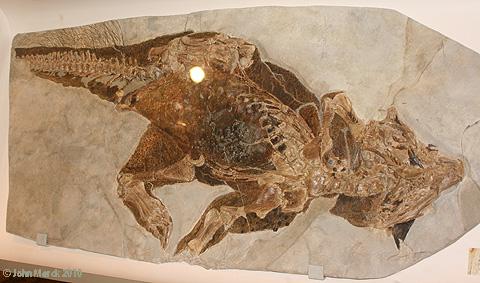
Psittacosaurus from Jehol Group - Jehol Group (Early Cretaceous Liaoning, China)
- Environment: lacustrine (lake) deposit with volcaniclastic sediment
- Preservation: carbonized films of soft tissues
- Significance: abundant preservation of flowers, insects, vertebrate integument (including mammalian fur, reptilian scales, and dinosaurian feathers).
- Messel Fossil Pit (Paleogene - Hesse, Germany)
- Environment: lacustrine deposit with volcaniclastic sediment
- Preservation: carbonized films of soft tissues. Combination of low sedimentation rate and die-off of aquatic creatures in upper lake layers due to seasonal turnover of anoxic bottom water makes this a Konzentrat-Konservat-lagerstätte.
- Significance: Reflects forest biota close to the Paleocene-Eocene Thermal Maximum. Abundant preservation of flowers, insects, vertebrate integument (including mammalian fur, reptilian scales, and feathers).
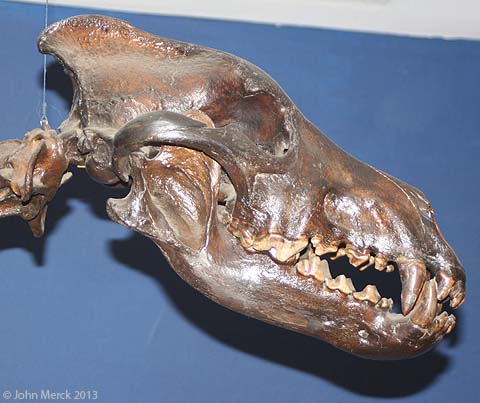
Canis dirus from Rancho La Brea - Rancho La Brea (Quaternary - California)
- Environment: Tar seeps concealed beneath ponds - a concentration trap favoring preservation of predators
- Preservation: Largely unaltered three-dimensional preservation of vertebrate bone and insect cuticle.
- Significance: Reflects the biota of North America immediately prior to the arrival of humans.

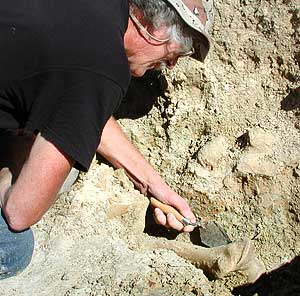
.jpg)
